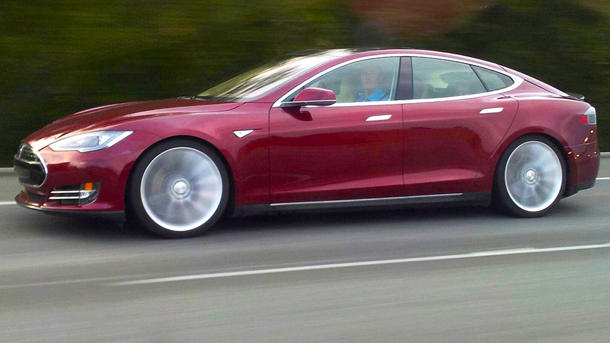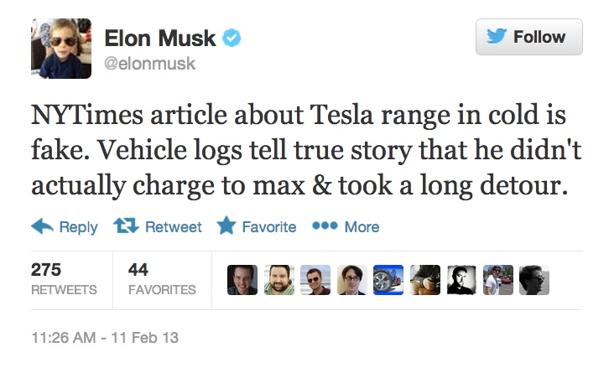Elon Musk calls out New York Times after Model S strands test driver
By Justin Hyde | Motoramic – 22 hours ago Most
new-car test drives rarely evoke drama, even those involving the
Spanish police. But a recent trip by a New York Times writer up the East
Coast in a Tesla Model S not only produced teeth-grinding suspense but a
nervous reaction on Wall Street and an accusation from co-founder Elon
Musk that the story was "fake." "Range anxiety," it turns out, can apply
to both electric cars and the companies that build them.
Most
new-car test drives rarely evoke drama, even those involving the
Spanish police. But a recent trip by a New York Times writer up the East
Coast in a Tesla Model S not only produced teeth-grinding suspense but a
nervous reaction on Wall Street and an accusation from co-founder Elon
Musk that the story was "fake." "Range anxiety," it turns out, can apply
to both electric cars and the companies that build them.For his drive, Times writer John Broder took the Tesla Model S sedan and its 265-mile range from Washington, D.C., to Norwich, Conn., to test the new "supercharger" free charging stations Tesla had installed along Interstate 95. Trouble began, as it often does, in New Jersey, when the Model S' range estimates began dropping faster than Broder could rack up miles.
To make his stop in Milford, Conn., Broder had to drive without heat and at 54 mph, about 26 mph less than the average observed speed on northeastern turnpikes. He made it, barely, and recharged for an hour to get 186 miles back in the batteries. After driving an additional 80 miles, Broder parked — without plugging the Model S in — and spent the night, ready to use the 90 miles showing on the car's range guide the next morning.
When that cold morning arrived, the Tesla had a surprise: Overnight, its batteries had lost enough charge to cut the car's range to 26 miles. After an attempt to recharge at a nearby quick charging outlet, the Model S died on the road and had to be lifted by flatbed — since its electric parking brakes would not release without current — to the Milford station.
The winter weather played a large role in the Tesla's poor performance; all electric vehicles hold less energy in temperature extremes. Tesla also gave Broder conflicting, and at time incorrect, advice about how to get the most energy from the car. And the location of Tesla's free charging stations in Newark, Del., and Milford require the car to get almost exactly its full range to cover the distance.
 In
the story, Broder quotes a Tesla executive saying the drive was
"disappointing" and "a good lesson." Elon Musk — who sued the BBC's Top
Gear over its staging of a Tesla Roadster losing charge – pushed back
much harder on Twitter Monday, accusing the Times of publishing a "fake"
story and saying the data logs from the Model S would tell a different
story. He also said Tesla would let other journalists take the same trip
to prove the Times wrong.
In
the story, Broder quotes a Tesla executive saying the drive was
"disappointing" and "a good lesson." Elon Musk — who sued the BBC's Top
Gear over its staging of a Tesla Roadster losing charge – pushed back
much harder on Twitter Monday, accusing the Times of publishing a "fake"
story and saying the data logs from the Model S would tell a different
story. He also said Tesla would let other journalists take the same trip
to prove the Times wrong.Musk expanded on those comments in an interview with CNBC, saying the logs showed Broder "had not charged up to the maximum charge in the car. It's like starting off a drive with a tank that's not full." He added that in Manhattan, Broder had taken a detour and drove fast enough to decrease the car's range, going on to describe the story as "unreasonable" and "misleading."
Eileen Murphy, a spokeswoman for the Times, said in an email statement that the story was "completely factual."
Any suggestion that the account was "fake" is, of course, flatly untrue. Our reporter followed the instructions he was given in multiple conversations with Tesla personnel. He described the entire drive in the story; there was no unreported detour. And he was never told to plug the car in overnight in cold weather, despite repeated contact with Tesla.Had this story run any other time, Tesla and other electric vehicle supporters could have easily shrugged off the ride as another quirk in the adventure. Model S owners have reported several glitches in the car; last December, a Model S left an Autoweek writer stranded and required an emergency house call from a Tesla mechanic. But we're days away from Tesla reporting fourth-quarter financial results, from when the company was reaching full production on the Model S. Investors pushed Tesla's stock down on the story this morning; one analyst told The Wall Street Journal the earnings would be "the make-or-break quarter." That's hyperbole, but after years of talk Wall Street wants proof Tesla can make money building $90,000 electric cars. Without it, the ranks of the anxious will keep growing.

No comments:
Post a Comment